Answer these simple questions and we will find you the BEST prices
Which type of solar quotes do you need?
It only takes 30 seconds
100% free with no obligation

Get up to 4 quotes by filling in only 1 quick form

Compare quotes and find yourself the best deal

Increase the value of your home by installing new doors
- whatcost.co.uk
- Doors
The Doors Guide for Your Home in the UK

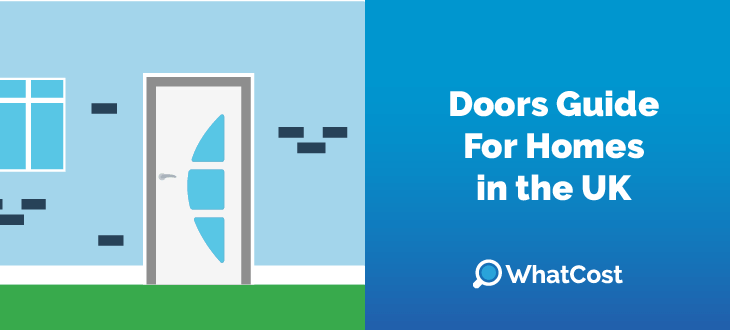
- Different door designs include contemporary, cottage, stable, sliding, bifold, and french doors.
- Typical door materials include uPVC, aluminium, wood, composite, and steel.
- The average price of a door will be between £500 - £2,000, with the total range being anywhere from £350 to £6,750.
Creating an inviting entrance to a room or your home is crucial for any homeowner. That’s why you need to know what doors will be best for your house. Choosing a door isn’t just an aesthetic distinction either, as different doors can allow for varying savings on heating, provide different lighting levels, and increase a home’s value.
Throughout this guide, we’ll go over the various types of doors, what materials they could be made from, and what they cost.
However, if you’re looking for new doors for your home, we can help with that as well. Our network of reliable installers can easily provide you with multiple prices so you can choose the best one. It’s much easier than taking up days hunting down companies and comparing their prices on your own. Click the button below to receive up to 4 free, non-binding quotes.
- Quotes from local installers
- Payment by finance available
- Save up to £150 per year
It only takes 30 seconds

The different types of doors
Doors come in many shapes and sizes depending on their location, size, security features, and function. External doors go to the front and back, requiring more security features and better glazing. Doors can also have additional panels or differing opening mechanisms, which can alter their size and costs.
Front and back doors
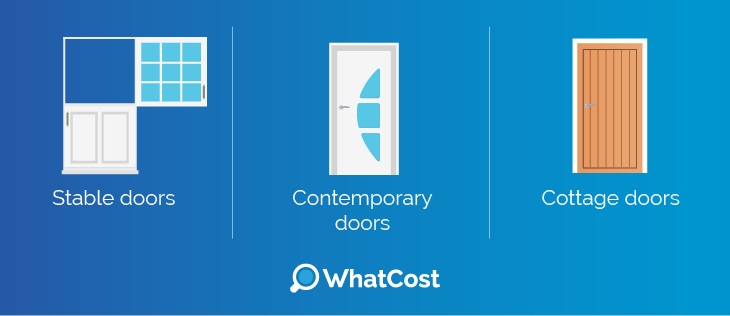
Since front and back doors provide entry points to the home, they often have very specific features, functions, and forms. These doors have security features like knobs with locks, often need better glazing, and are better sealed to prevent heat escape to the outside.
Contemporary doors
The standard type of front or back door. It’s a simple and effective design that can be cost-effective (starting around £340 for a basic design). Contemporary doors can be completely opaque or can have a glazing element. The glass on these doors is usually not as large as other designs like bifold or sliding doors (which can be largely glass).
Contemporary door price: £340 – £2,235
Cottage doors
Named for their origins in English cottages, these doors have a simple design: a large wooden frame and windowless body. They may not let in any light, but they are a sturdy entryway that can provide fewer concerns about glazing and glass maintenance. They have a traditional design that meshes well with classical architecture.
Cottage door price: £90 - £500
Stable doors
Stable doors are a great option for backdoor installations. They offer two openings and are split across two vertical wood panels, similar to horse stables or doors from old Westerns. This feature provides versatile ventilation and lighting options, as the top or bottom halves can be opened separately.
Stable door price: £200 - £1,250
Patio doors
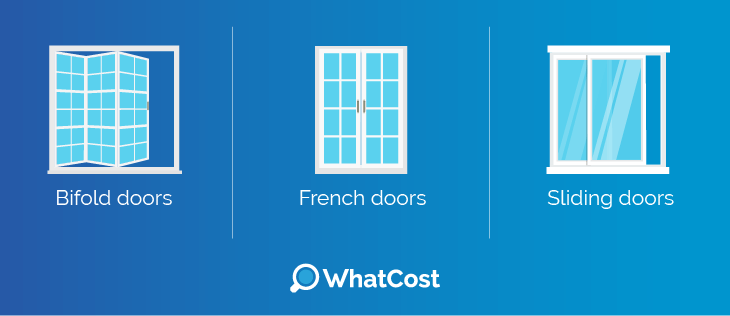
Patio doors are also external facing doors but are often more ornamented. They provide crucial spots for light entry and require good glazing to keep the cold out. Unlike interior doors, they also need some better security features and are often aesthetically pleasing.
Bifold doors
Composed of 2 or more panels, bifold doors can make for a great patio door. These doors open sideways, and they stack along a horizontal opening, much like sliding glass doors. The doors offer an even bigger opening than sliding doors since they can fold along the side, which makes them ideal for ventilation.
Bifold door price: £1,760 - £6,750
French doors
French doors come in many variations, but their defining qualities are double-door designs with glazing and grid lines. They can be a luxurious spin on a double-door design with glazing that allows for varying amounts of lighting depending on the number of glass panels and their size. French doors can have many different designs, so they are a versatile option.
French door price: £750 - £2,365
Sliding doors
Sliding doors are more than a cool aesthetic choice. They can save a lot of space since they don’t take up any interior space when they open up by sliding sideways. They are also great for lighting up a space, as they typically have very large glass panes.
Sliding door price: £800 - £3,500
Regardless of what door design you want, prices can vary greatly. This depends on the installer you choose, which is why it’s important to find a trustworthy one after reviewing multiple options. WhatCost can help with that by providing you with up to 4 free, non-binding quotes without any of the hassles of spending hours researching and calling up companies on your own.
Click the button below and fill out a short 30-second form to receive the best offers in your area.
- Quotes from local installers
- Payment by finance available
- Save up to £150 per year
It only takes 30 seconds

Door materials
The materials you choose for your door can impact the sustainability of your home, the lifespan of your installation, and factors such as noise reduction and potential maintenance issues. Let’s look at some of the main ones worth considering.
uPVC doors
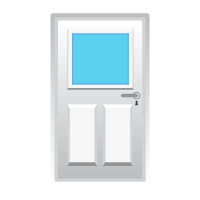
Unplasticised Polyvinyl Chloride, or uPVC, is a popular choice in the UK. A typical uPVC door can be the cheapest while still being a sustainable alternative. It usually has an all-white exterior, but it can also be coloured into numerous shades. While uPVC does not have the longest lifespan, it can be easy to maintain and requires little maintenance.
uPVC is great for simple internal doors as it is a cost-effective option.
Pros
- Affordable: Being one of the cheaper materials, a uPVC door can be up to 4 times cheaper than a wooden door of the same size.
- Low maintenance: They require very little cleaning and maintenance, being far easier to keep up to scratch than wooden windows.
- Recyclable up to 10 times: uPVC doors are fairly recyclable, allowing for reuse.
Cons
- Comparatively low lifespan: Out of the most common materials, uPVC can degrade the quickest. However, it also has far lower costs and maintenance requirements.
- Comparatively weaker material: Compared to metallic and wooden doors, uPVC can be a bit more brittle. It can also expand and contract more easily than other materials listed.
Wooden doors
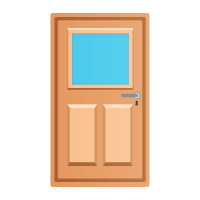
Wooden doors are the best option in terms of lifespan, sustainability, and recyclability while also providing a traditional look. They may be the most expensive, but as a replenishable resource, wooden designs provide sustainable options. Additionally, softwoods are the most sustainable option since they grow faster than hardwoods, although they can be a bit less durable.
Wood can require a little bit of maintenance and the occasional polishing. These help keep away wear and tear, along with keeping away pests like termites. However, well-maintained wood can last upwards of 80 years, making it worth the effort.
Pros
- Long lifespan: Not only can these doors last a long time, but their lifespan also means that you can easily trade and recycle them in fairly good condition if you desire.
- Endlessly recyclable: Wood can be permanently recycled as long as it is in reasonable condition. Since they last a lot longer, second-hand wooden doors can still be a great option for saving costs.
- Easy to repaint: Wood is ideal for repainting and renovating. Its look can be improved easily, and any abrasions or wear and tear can be easily hidden.
- Eco-friendly: Wood is the best option for the environment (depending on the type of tree it’s derived from).
Cons
- Require maintenance: Wooden doors require more care to avoid a host of issues such as warping or decay.
- Expensive: These doors are often the most expensive. However, they also provide adequate energy savings for far longer than any other material.
Aluminium doors
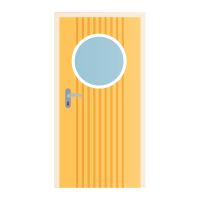
An aluminium door is a great option for a more sleek, modern appearance that can accommodate larger glass panes while having thinner frames. These can be great for patio doors or bifold designs that need to bring in more light. Aluminium is a great mid-range option with a better lifespan than uPVC while still being cheaper than wood.
Aluminium doors provide decent insulation properties while being fairly light and strong simultaneously. The thin, metallic designs can be aesthetically pleasing for many homeowners.
Pros
- Strong material: Aluminium is a strong material. It allows for better security and thinner frames, which in turn allow for broader aesthetic possibilities.
- Modern look: The metallic look can be modern and clean-looking, with less bulky frames.
- Decent lifespan: Aluminium doors can last over 40 years and require relatively low levels of maintenance.
Cons
- Moisture damage: Exposure to moisture can be very hazardous for aluminium doors and windows. This makes them less than ideal for seaside properties.
Steel doors
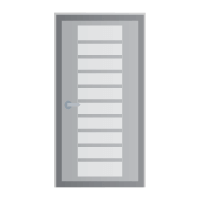
Steel doors are the strongest type of door for any household, making them a great choice for external doors. Sturdy and secure, they can be a great addition to properties with unique security needs or areas prone to extreme weather conditions. They are also a decent mid-range option, rivalling the prices of aluminium doors.
One thing to look out for with steel doors is the variability in lifespans. There are many different compositions of steel which have varying properties and prices.
Pros
- Sturdy material: The most secure type of door, offering enhanced security. It’s very hard to break steel (although it can be prone to scratches).
- Affordable metal: Many variants of steel are even more affordable than aluminium.
- Energy efficient: Especially when fitted with foam, steel doors can be exceptionally great at keeping in heat.
- Great noise reduction: Steel doors can be a great noise insulator. This will ensure solitude within the home, making them a great choice for external doors.
Cons
- Quality can vary: Depending on the type of steel, the door can last anywhere from 30 to 80 years (even more in some cases). This will require adequate research beforehand.
- Scratches and abrasions: While steel is quite sturdy, its outer layers can take on aesthetic defects like dents and scratches fairly easily. Steel may require the occasional repainting.
Composite doors

Composite doors are a mixture of multiple different materials that allow for unique properties. They are often mixtures of fibreglass, wood, polyvinyl, or laminate. The materials that result from these mixtures can embody the best of both worlds. These can come in a variety of material compositions and colours, offering differing properties as well.
Pros
- Energy efficiency: Composite materials can be twice as thick as uPVC, which allows for better energy efficiency and temperature control while still being cheaper than wood.
- Weather-resistant: Composite materials are very resilient and the mixed use of plastics, vinyls, and woods or metals can give them a lot more resistance.
- Multiple varieties of materials: Composite materials can come in many different combinations and colours. These can suit a variety of functions and locations.
Cons
- Potential cracking and warping: These materials can warp in extreme weather changes.
Secondary, double, or triple glazed doors
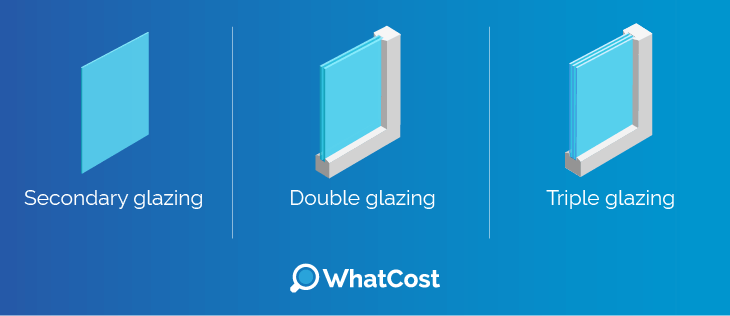
Aside from the material and design, another core consideration for your door is the type of glazing it will have (assuming it can accommodate glass panels). In the UK, the most common form of glass for windows and doors is double glazed. However, there are many older homes that might still have single glazed door panels, which can be less energy-efficient.
Double glazed windows and doors provide better noise reduction, better insulation, and are more secure than standard single glazing. You can take all of these features one step further by installing triple glazed doors, but this can be more expensive, and you may not see the benefits of triple glazing if you don’t live in a region that is cold enough to require the extra layer.
While less effective than double glazed windows, secondary glazing has its own advantages. It’s cheaper than double glazing. It is also easy to install on top of an existing window frame and is less intrusive. This often makes secondary glazing a great option for conservation areas, where the range of permitted home improvements can be limited.
What is the cost of a new door?
The average price of a door will be between £500 to £2,000, although prices can vary wildly. For example, new front door cost might fall within this range, but prices can be as low as £90 or as high as £7,000 for some outliers.
| Type | Supply Cost | Cost + Installation |
|---|---|---|
| Contemporary | £340 – £2,235 | £840 – £4,235 |
| French | £750 - £2,365 | £1,250 - £4,365 |
| Bifold | £1,760 - £6,750 | £2,000 - £7,500 |
| Stable | £200 - £1,250 | £500 - £1,550 |
| Sliding | £800 - £3,500 | £1,200 - £4,500 |
| Cottage | £90 - £500 | £200 - £1,000 |
Door grants
There are no grants specifically for the installation of new doors but certain initiatives allow for repairs and improvements that may include draught proofing them and improving their glazing to double glazing.
Certain grants can help improve your doors' energy ratings, but they are based on inspections and recommendations from assessors who can advise these measures among many options.
| Grant | Type of installation | Regions covered | Eligibility criteria | Timespan |
|---|---|---|---|---|
| Affordable Warmth Scheme | Draught-proofing windows and doors, replacing single glazed windows | Northern Ireland | Residents earning under £23,000 annually | September 2014 - ongoing |
| Home Upgrade Grant (HUG2) | New windows, doors and draught-proofing | UK | Low-income households, off-grid, low energy efficiency rated properties | April 2023 - March 2025 |
| Home Energy Scotland Grant and Loan | Upgrading single glazing only when advised (grant available). Draught-proofing can be accessed through a loan. | Scotland | Scottish homeowners | May 2017 - ongoing |
Should I get a new door for my home?
Installing a new front door can be a great investment as it improves your home's energy efficiency and aesthetic appeal. As outlined by the various grants that help pay for glazing and draught-proofing, new doors can also improve your home’s Energy Performance Certificate rating and quality of life. Changing your door or its glazing can also improve interior lighting.
While it’s true that choosing the home doors can be a bit of a hassle, it doesn’t have to be. Looking up companies and researching them on your own is a laborious task, but our service can take the stress out. Simply fill out a 30-second form, and we’ll do the rest, saving you hours of research. The installers in our network are thoroughly vetted and can provide the best prices.
Click the button below to receive up to 4 free, non-binding quotes.
- Quotes from local installers
- Payment by finance available
- Save up to £150 per year
It only takes 30 seconds

FAQ
Types of doors include contemporary, french, stable, bifold, and sliding doors, among many others. The types of doors can vary based on function, placement, size, glazing, and number of panels they have.
The most common materials for doors are uPVC, aluminium, wood, steel, and composites. Each of these has its own distinct advantages and disadvantages.
How long a door lasts varies based on the material, with wooden doors lasting upwards of 50 years if well-maintained. In contrast, uPVC doors may last about 25 years.
Despite the costs, a new door can add to a house’s value and help improve energy efficiency.

Rawal is an ex-tech journalist with a passion for sustainable innovations, green policies, and their adoption. With a straightforward writing style meant to be easily digested but full of handy tips, they are geared towards readers of all levels of familiarity with the technologies and home appliances covered.
